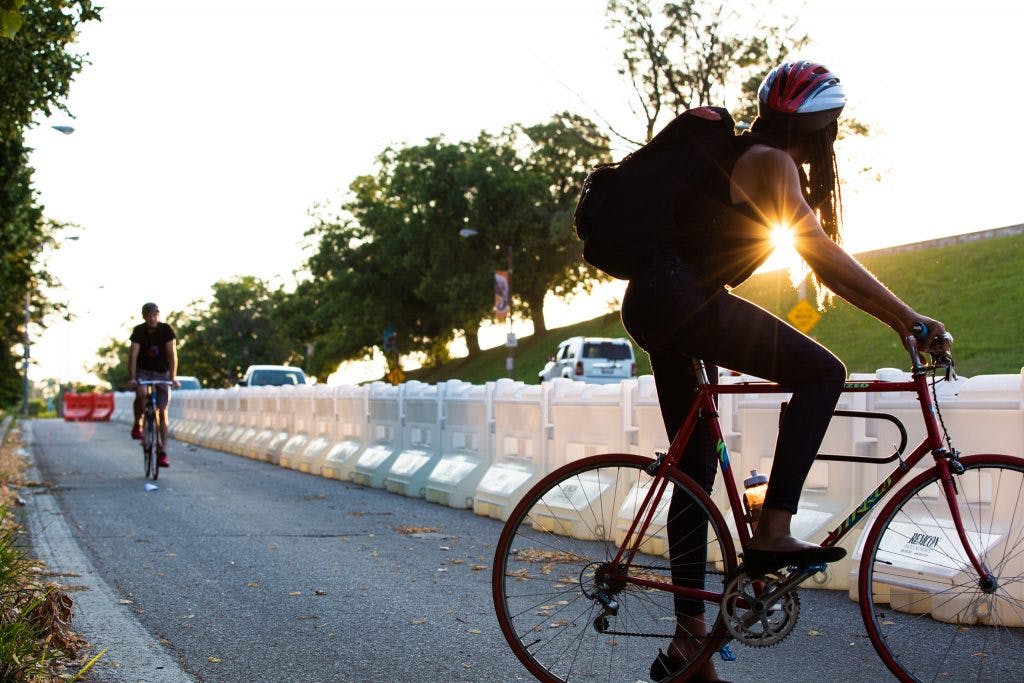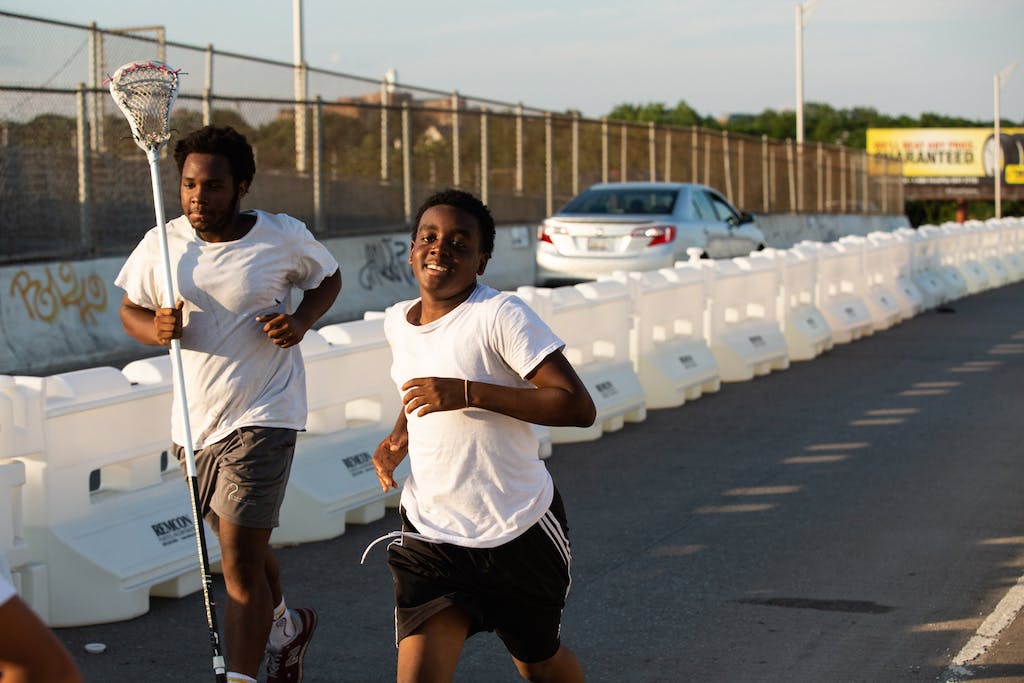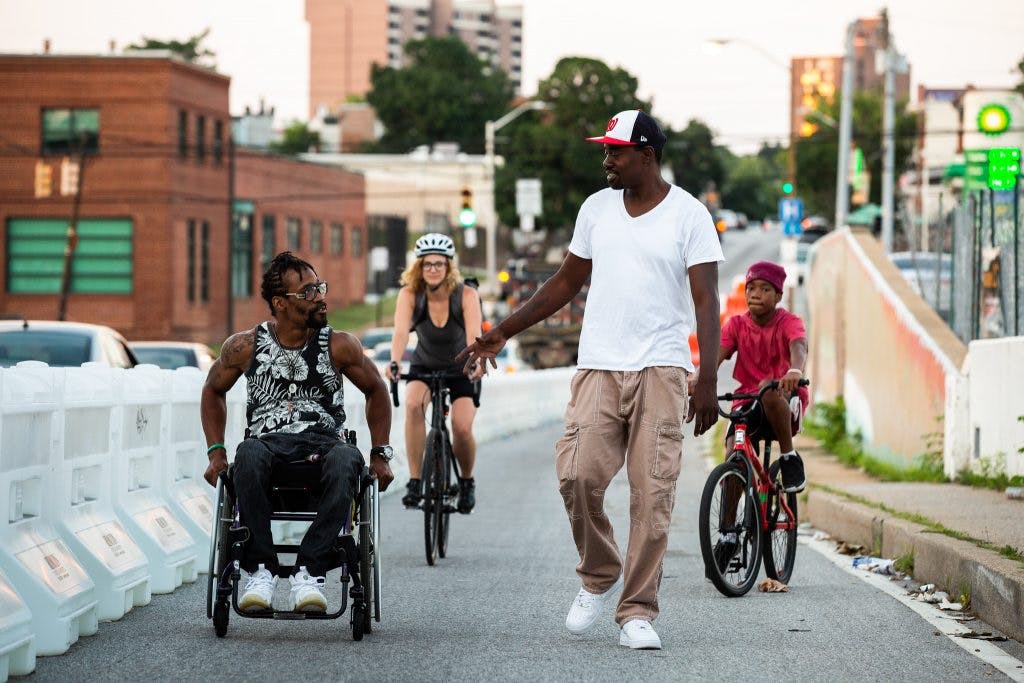Explore Our Network of Sites
Search
By:

After recent bicycling infrastructure setbacks, Baltimore scored a big win for accessibility and connectivity.
In June, the city deployed temporary, water-filled barriers to create a new 1.3-mile protected path that reconnects surrounding neighborhoods to each other and to the city’s premier park. The project is part of Baltimore’s efforts to reimagine its bicycling network—the city was selected as one of 10 locations for PeopleForBikes’ Big Jump Project, providing Baltimore with technical support to implement bike infrastructure projects.
The new path runs along the south end of 745-acre Druid Hill Park, easing access to the park’s trails, public pool, pavilions, zoo and other recreation areas. The park was effectively cut off from adjacent communities after a highway-building spree that began in the 1940s resulted in four to eight lanes of traffic between the park and nearby communities. Crosswalks are few and far between.
“In many ways, you need to get into a car, drive across the roadway and park inside the park in order to enjoy it, which is crazy,” says Matt Warfield, bike planner for the city’s department of transportation.
The new trail along Druid Park Lake Drive enables people of all ages and abilities to cross more easily into the park. The park trail also connects pedestrians and bikers to existing trails that form a 2.5-mile recreational loop through the neighboring communities, reconnecting areas of West Baltimore that have faced decades of disinvestment after being isolated by surrounding highways.

The new pathway is more than convenient; for many locals, it’s life changing.
For residents of Reservoir Hill, a predominantly black neighborhood where two-thirds of households don’t own cars, walking to jobs and shops in more affluent Remington once meant navigating a narrow sidewalk across the 28th Street bridge while traffic whizzed close by.* The trip was out of the question for people using wheelchairs or those with limited mobility.
Baltimore City Councilmember Leon Pinkett championed the project and is thrilled with the outcomes. “As excited as I am about the pedestrian use of it and the bicycle use of it, I am most encouraged by those who are disabled, who for the first time ever have been able to travel east on that road,” he says. “That’s not a small thing.”
It’s also no small thing that the project was completed, says Jed Weeks, policy director for Bikemore, the local bicycling advocacy group that worked with Pinkett and the local communities to implement the protected lane.
“We are a city that rarely takes bold steps on transportation,” Weeks says. “This is a big jump for our department of transportation and our city leadership to take.”
The project is already making a difference. Before the path went in, Weeks had seen the same man walking across the bridge hundreds of times. “He always had his head down, and he just looked like he was clinging to the fence on the edge of the bridge and staying as far away from the cars as possible,” he says. “I saw him the other day, and he had headphones in and he was dancing down the sidewalk.”

While some complaints about longer driving times through the project area have surfaced, the community is overwhelmingly supportive, says the transportation department’s Warfield. That support enabled the city to take the risk and bear some of the resulting backlash.
The city is now making adjustments to address concerns, such as improving signal timing and installing a left turn signal at one intersection.
Weeks says the nature of the project made it more adaptable. “The beauty of a pilot project like this is we were able drop it down, see the challenges within two to three weeks, and then respond to them,” he says.
The long-term fate of the trail remains to be seen. The current plan is to keep it in place for at least a year while the city assesses how many people use it and how it affects traffic patterns. At the same time, the transportation department has begun a larger study of options to improve access on all sides of Druid Hill Park, which will help inform whether the trail becomes a permanent installation.
If the trail along Druid Park Lake Drive is made permanent, the city hopes to use the water-filled barriers — which it purchased for about $500,000 — to test out similar projects elsewhere.
In the meantime, the new path has generated some much-needed optimism about the future of biking and walking infrastructure in Baltimore.
“I’m hearing people hopeful about other projects and other initiatives,” says Councilmember Pinkett. “If we would take a bold step like this, imagine what we can do if we continue to collaborate and be creative.”
The community will gather to celebrate the Druid Park Lake Drive trail on August 26.
*The resulting Bicycle Network Analysis (BNA) score for the combined Reservoir Hill and Remington neighborhoods increased by 5 points as a result of this strategic investment to alter a high-speed highway into a comfortable, protected pathway.